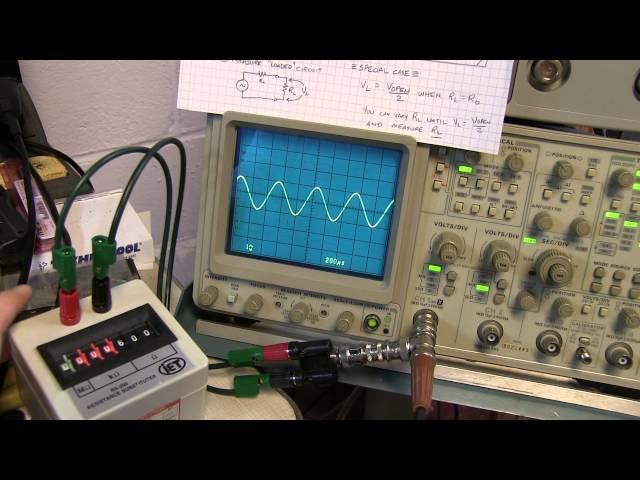Комментарии:

Great video! Very well put together, perfectly explained, and super useful information. Thanks for your work!!
Ответить
Hi Alan. I'm building a CW transmitter. I have a buffer amplifier after the crystal oscillator. I tried measuring the output impedance of that stage using the method you described (with two load resistors). I calculated the output impedance . I then tried another pair of resistors (with different values) to see if I come up with the same output impedance. I did not. It was quite different. Could the output impedance change based on the load?
Ответить
Could someone explain to me how to measure and calculate the output resistance of the RF generator. The minimum frequency on the device is 120 KHz. Judging by this video, such a high frequency would give me a bad result. I'm just a hobbyist, that's why I'm asking.. I just don't know .... 😅
Ответить
You do realise that impedance is a complex quantity, and not in general a simple resistance - right??
Ответить
See ya later oscillator!
Ответить
Thanks. This is helpful. Best wishes from New Zealand.
Ответить
This is an excellent video! Do you have a similar video on measuring the input impedance?
Ответить
Dear Alan,
I have RF magnitude and phase probe circuit with two toroids connected to 4 diode based peak detectors to give output voltage corresponding to magnitude and phase errors detected. I am somehow not sure how that voltage is mapped to magnitude and phase errors and in what ratio. This circuit is inside a 300W auto matching network which is used to do impedance matching. Load is a sputter source which is used to do sputtering. Generator is a 13.56 MHz, 300W unit. The circuit which I was talking about senses this magnitude and phase error and gives a feedback to a microcontroller which in turn rotates ganged series and shunt capacitor to match the impedance. I just want to understand the circuit better and make know how to make which motor move to get to 50 ohms.
I am missing some bits and parts due to which my understanding about this thing is not complete. Please help me understand this thing. Let me know if you want any circuit diagram from or anything else. Thanks !

Perfect
🌟🌟🌟🌟🌟

You use the term impedance but only consider that the output impedance is purely resistive. What about the condition where the output "impedance" has reactive [capcitive or inductive] elements along with the resistive element? Should consider taking measurements using more than one frequency.
Ответить
Thank you very much. Do you have a video that covers how to measure the reflected impedance that a transformer's source/driver (or primary winding) experiences given a particular load on that transformer?
Ответить
Very useful thanks :)
Ответить
Couldn't you output calculation as " LOAD ohms X (v2/(v1-v2)) = device input impedance " simple instead of oscilloscopes can be used diod bridge made of 4 diodes and a cap of 10uf simply make a switch that passes original signal v1 through switch to volt meter and another position on switch to pass signal including load in known ohms as v2 then voltages us as in my formula above ..in that case formula is spot on and can be used without oscilloscope.. I made such PCB for myself
Ответить
How do you measure the output impedance of high frequency devices, for example a crystal oscillator (if it makes sense) or an amplifier?
As usual, thanks for your videos!

Occ-il-Later, you be a funny man. It's the imaginary component that trips me up when trying to figure out Impedance for RF
Ответить
The output impedance of the collector of a Darlington transistor is higher or lower compared to a bjt's collector output impedance? But I have heard is that a darlington's output impedance on The collector is much lower compared to a bjt's output and complaints on The collector but what is the advantage of the output impedance of a darlington's collector compared to a bjt's output impedance collector?
Ответить
Are able to provide the schematic for that wave generator?
Ответить
When converting high impedance to lower impedance the signal drops down 20dB or more. This means that high impedance audio signals has more current drive, power, energy compared to low impedance audio signals? because what is the difference between an audio signal that is high impedance audio signal compared to a low impedance audio signal? it must have to do with the signals energy and power?
Ответить
Oscillator
Ответить
Very clear explained. thanks
Ответить
Yet another excellent video. Can you use the same method to measure the input impedance of lets say a common emitter amplifier or any other type of electronic circuit?
Ответить
Nice and straightforward.
Ответить
Where do I learn the concepts like reflection
Ответить
👍👍
Ответить
Great video. Love the HP-15C!
Ответить
How about testing the output impedance of a ham radio in the HF range from 160 meters to 10 meters?
Ответить
Excellent video. Thank you!
Ответить
Nicely done, as always.
Ответить
🌹✝️🌹
Ответить
I have a TC Helicon Harmonizer pedal. MIc in, through the effect then back out to mic in amp etc.
It works as expected on many different amps, but does not work well with my Fender Acoustic Jr GO.
The amp 100W and with the TC pedal, out put volume is lower than an plain acoustic guitar with no amplification. It is not my amp it is an incompatibility with this model of Fender, tried 4 amps.
I am suspecting an impedance mis match. TC is 400 ohm out. I have no input data for the Fender but both channels accept XLR for mic or 1/4 unbalanced for a guitar.
Anybody's thoughts on what might being going on, and also ways to test/measure or add something between the pedal and amp mic input greatly appreciated. Cheers

Thanks for all the videos!
Ответить
unfortunately this video didn't help me because impedance is complex and if I only know what the real part is then I still don't know what the output impedance actually is (in my case I'm trying to figure that out for a transistor).
Ответить
Great video, sir. But how to measure the output impedance of an RF signal generator with a Directional Coupler and a Spectrum Analyzer?
Ответить
Love that step resistor box. I need to make or buy one. You explained this process much MUCH better than my "engineer" instructor. Thanks Allan
Ответить
Cool beans.
Ответить
Just out of curiosity, what is this signal generator built upon? 20-30 years ago, i'm guesing it's opamps? or is it discrete?
Ответить
That was a good video Allan !!! GLX/73's
Ответить
Rather than memorizing a formula you can also see that the open circuit voltage equals the internal, Thevenin equivalent voltage since no current flows through the output (Thevenin) resistance. When you add a load resistance, you can divide the new output voltage by the load resistance to find the current flowing through the loop. Also, the change in output voltage MUST be due to Ohm's law applied to the output resistance.
Thus, V_loaded = V_open - IR_output or R_output = (V_open - V_loaded)/I. Since
I = V_loaded / R_load this yields the formula.
ALWAYS the output resistance is R_out = -dV/dI by definition. You need only apply two different loads (resistances), measure the two output voltages, deduce the two output currents, and compute this slope. Be aware that taking the difference between two nearly equal numbers always loses precision so you need to make the two loads as different as practical.

your videos are indispensable. thank you.
Ответить
Lowering load Z (or R) also shifts the HPF created by output DC blocking capacitor (if any) upwards, so, f must be high enough compared to the cut-off freq of that.
Ответить
Please understand that I really enjoyed your video and you are a good teacher. On top of that did your thumbnail clearly show that your video was about low frequency. But I am looking for high-frequency impedance measurements, do you know someone with your teaching skill level that is covering that subject? :-)
Ответить
If the output impedance is 7K and the next following stage/section input impedance is 1K, is the output impedance 7K gets loaded down to 1K? the difference is 6K between 7K and 1K so the "difference" between the output impedance and the input impedance is called what? and its 6K of a difference?
Ответить
When looking at the first stage/front end of an amplifier circuit, how can you tell if the first stage/front end is High impedance or low impedance? how can you tell how "sensitive' the front end will be to a low impedance input signal?
Ответить
Transitors, who needs them! investigate androidcircuitsolver on google
Ответить
Allen, is there a way to calculate the feed point impedance of an Antenna? Like an EFHW uses a 49:1 impedance transformation. How do one come to a conclusion that for HF bands the feed point impedance of an EFHW is around 2500 Ohms and required a 49:1 impedance transformer? I couldn't find a satisfying reply anywhere.
Ответить
im just a aermodellling hobbyist, right now i use the video transmitter with 5.8ghz freq , i need to know is this method can be used to measure the output impedance for my video trasmitter
Ответить


























